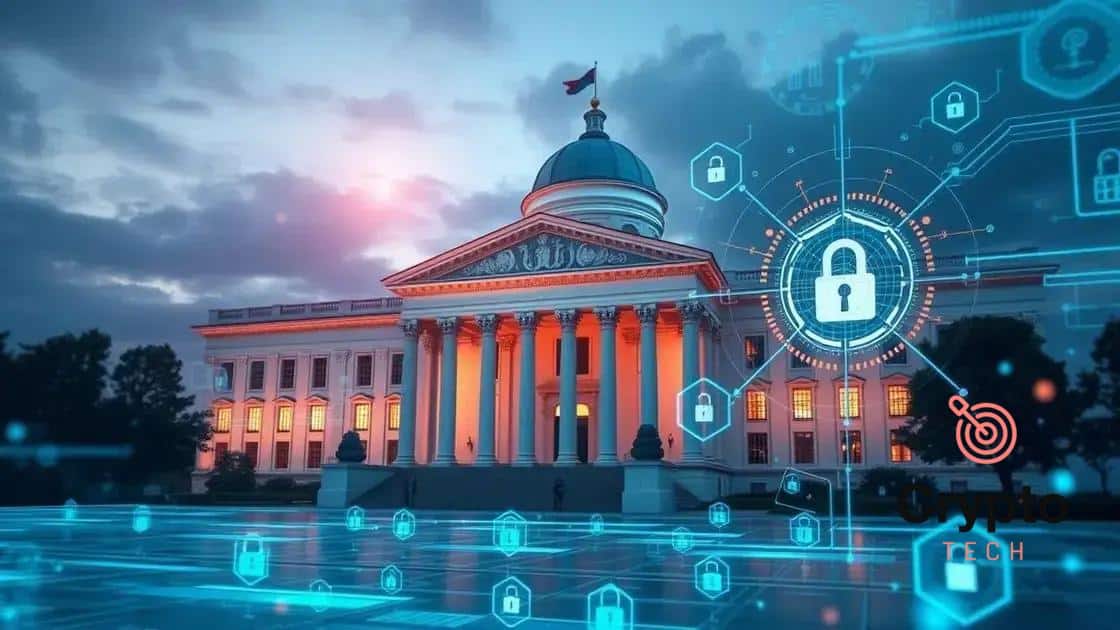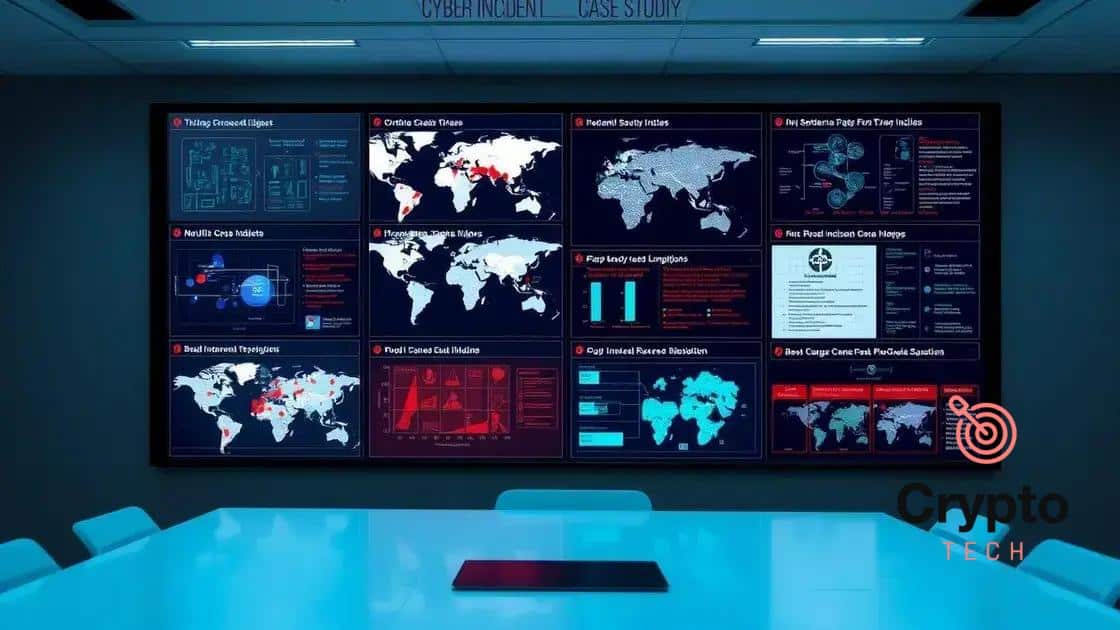Rise in cyberattacks against government agencies in 2025

The rise in cyberattacks against government agencies in 2025 emphasizes the need for enhanced security strategies, including AI integration, zero trust architecture, and robust data privacy measures to effectively combat these threats.
In 2025, the rise in cyberattacks against government agencies has become a pressing concern for citizens and officials alike. As digital systems evolve, so do the tactics of cybercriminals. This article will explore the implications and necessary responses.
Understanding the current threat landscape
The current threat landscape is ever-changing and becoming more complex. Understanding this environment is crucial for government agencies to protect themselves effectively. Cyberattacks are not just common; they are increasingly sophisticated and targeted. This makes awareness and preparation essential.
Types of Cyber Threats
Different types of threats pose risks to government agencies today. Recognizing them can help in devising effective strategies.
- Phishing attacks: These are often the entry point for hackers, tricking users into providing sensitive information.
- Ransomware: This malicious software can lock vital data, demanding payment for access.
- Insider threats: Employees with access to sensitive information can sometimes pose significant risks.
- Distributed Denial of Service (DDoS): These attacks can cripple services by overwhelming systems with traffic.
As the methods of attack evolve, so too must the strategies to combat them. Continuous updates and employee training are necessary to mitigate these risks. Moreover, government agencies need to collaborate with cybersecurity experts to navigate these challenges effectively.
Consequences of Cyberattacks
The impact of cyberattacks on government agencies can be profound. Beyond financial losses, trust between the public and government may erode. Sensitive data leaks can threaten national security. Protecting against cyber threats is not just an IT issue; it’s a responsibility that affects everyone.
Agencies must be proactive, adopting a robust approach towards cybersecurity. Implementing regular assessments and updates to their defensive measures is key. A strong cybersecurity culture within the agency can significantly reduce vulnerabilities and enhance readiness.
Impact of cyberattacks on public trust
The impact of cyberattacks on public trust is significant and alarming. When sensitive information is compromised, citizens often feel vulnerable and uncertain. This erosion of trust can create long-lasting consequences for government agencies.
Effects of Breaches
Data breaches can shake public confidence in how agencies protect their information. Citizens expect government entities to safeguard their data, and failures in this area can lead to skepticism.
- Loss of confidence: Individuals may lose faith in government capabilities to secure data.
- Public backlash: Citizens may demand accountability when breaches occur, leading to protests or calls for resignations.
- Increased scrutiny: Media coverage can elevate attention on agencies’ cybersecurity practices, impacting public perception.
- Change in behavior: People may become less willing to share personal information, hindering government operations and initiatives.
Restoring trust after a cyberattack requires transparency and proactive measures. Agencies need to communicate openly about what happened and how they plan to prevent future incidents. Such communication is key to rebuilding relationships with the public.
Building Public Trust Again
Government agencies should prioritize strengthening their cybersecurity measures. Implementing robust protocols and training employees effectively can minimize risks. Engaging the public through awareness campaigns can also improve trust.
Continuous improvement in security practices coupled with honest communication about challenges faced can reinstate confidence. By showing determination to protect citizen data, agencies can demonstrate their commitment to safety and security.
Strategies for government agencies to bolster security
Government agencies face increasing threats from cyberattacks. To combat these challenges, developing effective strategies to bolster security is essential. By implementing robust security measures, agencies can protect sensitive information and maintain public trust.
Implementing Comprehensive Training Programs
One key strategy is to implement comprehensive training programs for all employees. Cybersecurity awareness helps everyone recognize potential threats. Training should cover topics such as:
- Identifying phishing attempts: Employees must learn to spot suspicious emails and links.
- Safe browsing practices: Using secure websites protects sensitive information.
- Reporting mechanisms: Establish clear protocols for reporting suspected breaches.
- Incident response: Employees should understand how to react in the event of a data breach.
This training empowers employees to be the first line of defense against cyber threats. Continuous education keeps everyone informed about the latest cybersecurity developments.
Investing in Advanced Technologies
Another essential strategy is investing in advanced technologies. Government agencies need to stay ahead of cybercriminals by adopting cutting-edge tools. This may include:
- Firewalls and encryption: Implementing strong firewalls protects data from unauthorized access.
- Intrusion detection systems: These systems monitor networks for suspicious activity.
- Regular updates: Keeping software and systems updated reduces vulnerabilities.
- Cloud security measures: Safeguarding data stored in the cloud is crucial for protecting sensitive information.
By leveraging technology, agencies can enhance their defensive capabilities. Regular assessments also ensure that security measures remain effective against evolving threats.
Fostering Collaboration and Information Sharing
Collaboration between agencies can significantly improve security. Sharing information about threats and best practices leads to a collective defense. Setting up partnerships with private sector cybersecurity firms can also provide valuable insights and resources.
Creating a culture of security where everyone understands their role in protecting the agency’s information is vital. By implementing these strategies, government agencies can strengthen their defenses and ensure they are prepared for the challenges ahead.
Case studies of recent cyber incidents

Analyzing case studies of recent cyber incidents provides valuable insights into the threats facing government agencies today. Understanding these incidents helps agencies identify vulnerabilities and develop better defenses.
Incident 1: SolarWinds Cyberattack
The SolarWinds cyberattack in 2020 is one of the most significant breaches in recent history. Hackers infiltrated the software supply chain, affecting numerous government agencies and private companies. The attack showcased how vulnerabilities in software can lead to extensive risks.
- Targeted Agencies: U.S. Departments of Treasury, Homeland Security, and State were impacted.
- Key Takeaway: Strong supply chain security is essential to prevent similar attacks.
- Response: Agencies had to conduct thorough security assessments and strengthen monitoring protocols.
This incident highlighted the importance of continuously evaluating and updating security measures.
Incident 2: Colonial Pipeline Ransomware Attack
In May 2021, a ransomware attack targeted the Colonial Pipeline, disrupting fuel supply across the eastern United States. The incident demonstrated how critical infrastructure can be affected by cyber threats.
- Impact: The attack led to fuel shortages and panic buying, affecting millions.
- Lessons Learned: Critical infrastructure needs heightened protection measures and rapid incident response plans.
- Wisdom for Agencies: Collaboration with private sectors can enhance threat detection and response.
As a result of this incident, many agencies are reevaluating their incident response frameworks and crisis management strategies.
Incident 3: Microsoft Exchange Server Hack
In early 2021, a vulnerability in Microsoft Exchange Server was exploited, leading to widespread data breaches worldwide. This incident affected many government agencies and organizations.
- Scope: Thousands of organizations were estimated to be compromised, highlighting the extent of the threat.
- Critical Insight: Regular updates and patch management are vital to prevent similar occurrences.
- Action Steps: Enhanced security protocols and ongoing employee training are essential to mitigate risks.
Learning from these case studies allows government agencies to implement better security policies and avoid the same pitfalls in the future.
Future trends in cybersecurity for government
Understanding future trends in cybersecurity for government is crucial for staying ahead of threats. As technology evolves, so too must the strategies agencies use to protect sensitive data. Recognizing these trends can help agencies prepare and respond effectively.
Increased Use of Artificial Intelligence
One of the most significant trends is the increasing use of artificial intelligence (AI) in cybersecurity. AI can help detect and respond to threats faster than human analysts. This technology analyzes vast amounts of data to identify patterns that indicate potential attacks.
- Automated threat detection: AI can continuously monitor and alert agencies to unusual activity.
- Predictive analytics: Using AI to forecast potential security incidents improves response times.
- Streamlined incident response: AI tools can aid in managing and analyzing incidents more efficiently.
This shift towards AI will enable agencies to strengthen their defenses and improve overall cybersecurity posture.
Zero Trust Architecture
Another important trend is the adoption of a zero trust architecture. In this model, agencies do not automatically trust any user or system, whether inside or outside the organization.
- Continuous verification: Every access request is verified against security policies.
- Least privilege access: Users are given the minimum access necessary to perform their duties.
- Micro-segmentation: Network segments are created to limit potential attack surfaces.
This approach helps agencies minimize the risk of unauthorized access and data breaches.
Growing Focus on Data Privacy and Compliance
Data privacy is becoming increasingly important as regulations evolve. Agencies must prioritize compliance with various laws related to data protection. This focus leads to a trend of enhanced privacy measures, such as:
By aligning with these trends, government agencies can improve their cybersecurity frameworks and better protect the information they manage.
In conclusion, as we face an increasing number of cyber threats, it’s vital for government agencies to adapt their strategies. Embracing technologies like artificial intelligence can enhance threat detection and response. Moreover, implementing a zero trust architecture can help secure sensitive data by ensuring that only authorized individuals have access.
Additionally, focusing on data privacy and compliance with regulations is essential to protect citizen information. By staying informed about future trends in cybersecurity, agencies will be better prepared to defend against attacks and maintain public trust.
FAQ – Frequently Asked Questions about Cybersecurity Trends for Government Agencies
What role does artificial intelligence play in cybersecurity?
Artificial intelligence helps detect and respond to cyber threats faster by analyzing large amounts of data for unusual patterns.
What is zero trust architecture?
Zero trust architecture ensures that no user or system is trusted automatically; all access requests must be verified continuously.
How can government agencies improve data privacy?
Agencies can improve data privacy by focusing on compliance with data protection laws and implementing strong encryption practices.
Why is collaboration important in cybersecurity?
Collaboration allows agencies to share information about threats and best practices, enhancing overall security measures.





